#dna testing
Text
Getting a job at the shady discover-your-ancestry DNA testing outfit and doctoring everybody's results to tell them they're 50% pine tree.
2K notes
·
View notes
Text
The company said its systems were not breached and that attackers gathered the data by guessing the login credentials of a group of users and then scraping more people’s information from a feature known as DNA Relatives. Users opt into sharing their information through DNA Relatives for others to see.
...
The full picture of why the data was stolen, how much more the attackers have, and whether it is actually focused entirely on Ashkenazim is still unclear.
...
Callow notes that the situation raises broader questions about keeping sensitive genetic information safe and the risks of making it available in services that are designed like social networks to facilitate sharing.
...
“This incident really highlights the risks associated with DNA databases,” Callow says. “The fact that accounts had reportedly opted into the ‘DNA Relatives’ feature is particularly concerning as it could potentially result in extremely sensitive information becoming public.”
Yeah, so, don't reuse passwords, and be careful what kind of information you share purposefully or opt in to passively sharing.
Jesus fucking Christ.
#antisemitism#data breach#23 and me#DNA testing#i have been saying for years and years that something like this was going to happen#i have been tempted by DNA testing but i dont trust that shit to some random company#and this is fucking why
484 notes
·
View notes
Text
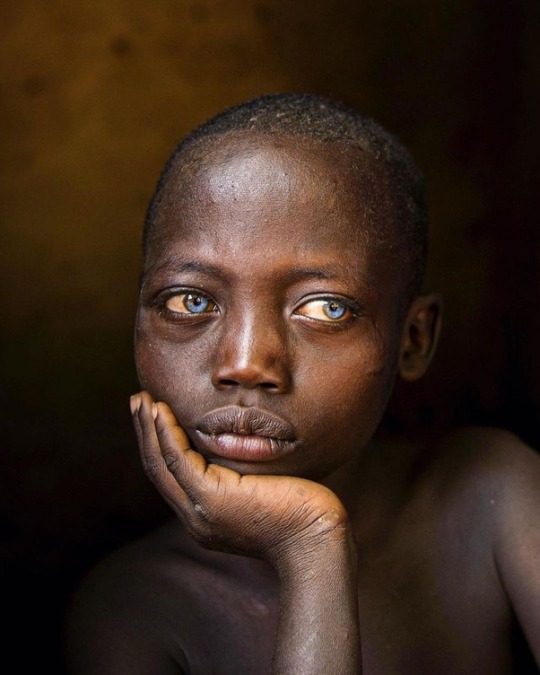
African populations have the highest levels of genetic variation among all humans.
#african#afrakan#kemetic dreams#africans#brownskin#afrakans#brown skin#african diversity#dna#dna testing
218 notes
·
View notes
Text
DNA Testing?
Hello! If anyone has any experiences at all with DNA testing for any reason whatsoever (fun, genetics, health, ancestry, etc etc), or knows anyone who has gone through it and knows the process, could you please let me know your experiences? The process, the company etc, basically how it all went!
Especially welcome input from adoptees but anyone at all is ok!!
#dna#dna tests#dna tracing#tracing#adoption tracing#adoption#adoptee#transracial adoption#international adoptee#dna testing
7 notes
·
View notes
Text
No because Jace and clary could’ve easily avoided a lot of problems and heartache with a simple dna test
#shadowhunters#tmi#the mortal instruments#city of bones#city of ashes#jace x clary#clary x jace#clary fray#clary fairchild#jace wayland#jace herondale#jace morgenstern#jace lightwood#dna testing#you’re my sister#cassandra clare
209 notes
·
View notes
Text

So my DNA test results updated.
They do once they get more and more samples in. That is how these tests work.
They go off of the samples that they have, and that they continue to get.
I did it to match with family and to see if I have any cousins out there. I do, and have matched with them.
My husband did his, and his second highest match was an 82 year old woman at the time who was trying to figure out who her dad was.
After much research, we came to the conclusion that she was his half-great aunt. His great-grandfather had a child before he was married.
This woman passed away a few years ago knowing who her dad was and that she had half-siblings out there. Who she did not meet cause they weren't nice people.
So I always say that these tests are good for finding family, but not for accurately guessing your heritage.
That will involve research.
5 notes
·
View notes
Text
Tamberlane and the thorny issue of adoption in roots work

Clearly, there are different types of roots, beyond what the teacher in these panels from Tamberlane is telling her. This is NOT what you tell someone about their roots. Teacher, you are doing this all wrong!
Reprinted from my Genealogy in Popular Culture WordPress blog. Originally published on March 8, 2021.
One of my favorite ongoing webcomics, Tamberlane, hits you right in the face with an issue which often faces genealogists: adoption. Tamberlane, the story's protagonist is told by her teacher, Ms. Callie. that they will be learning about "their roots." [1] This worries her, as she first thinks that it means she literally has roots growing out of her, and later when she learns that roots make you for "who you are." She is concerned because she's from the far-off place known as "Abroad" but her friends comfort her, reminding her that her roots are in Treehollow with the rest of them because she lives there. Cur later challenges Ms. Callie, asking about students who don't know their roots and starts making a scene. Later, the teacher is flustered and doesn't know how to answer questions about "Abroad," with Jentzen kicked out of the classroom as a result, just because he asked a question! This becomes a plot point later in the series, as Cur blames Tamberlane for Jentzen getting fired, even though it isn't Tamberlane's fault, leading Piper to get in a fight with Cur. [2] As it turns out, not even Tamberlane's guardian, Belfry, can adequately explain "Abroad" to her. [3]
Ms. Callie was wrong about roots. As Becks Kobel, a death positive genealogist [4] wrote in October 2017, "we are placed within families, whether biologically or through adoption, that have a long history with all sorts of experiences." Roots are not only based in your blood, but are wider ranging than that, including your chosen family, those you surround yourselves with, and your circumstances. They can be your roots. There are even some Italian surnames, like Esposito, which were given to children in Italy who were given up by their parents or were adopted! At the same time, a surname may be assumed because of an "unofficial adoption, taking on a stepfather’s surname and so on" as was the case with one of my ancestors, Robert B. Mills II (originally Robert Barnabas Packard). Some genealogists even warn about not being "lured into sympathy research via an adoption story" while others note that DNA tests can be helpful for those with ancestors who were adopted or those looking for their birth parents. Sure, you could say that the "standard" family tree wasn't made for adoption, but that doesn't mean it is invalid, as adoptees can be heirs to estate from time to time. Some stick with the so-called standard tree, as "Geni cannot record adoptions" but that doesn't mean that records of it doesn't exist. [5] Russian genealogist Vera Miller talked about this:
Many adoptees become curious about their birth families and hopeful their questions about their separations from their families will be answered. The challenges of some adoptees from the Russian-speaking world is facing that their Russian language skills disappeared or were never developed. Thanks to the Internet, these adoptees can find their families with just as much success as adoptees from the English-speaking world.
That brings me back to Tamberlane. She was, at the beginning of the comic, found in the woods by the citizens of Treehollow and while she isn't always good with communicating verbally, she knows a bit of pidgin Trissol (Silver Sage Sign Language). She calls herself "Tamberlane" when meeting Belfry for the first time in Chapter 1, with Belfry wondering where her parents are, and who left her there. As such, the other stuff I said about adoption isn't applicable here, although it is still worth noting. Hopefully, in the future, this is explored more in the webcomic.
© 2021-2023 Burkely Hermann. All rights reserved.
Notes
[1] Caytlin Vilbrandt, Tamberlane, Chapter 4, Pages 181-190, Issue 15 on WEBTOON, Jan. 2, 2020.
[2] Caytlin Vilbrandt, Tamberlane, Chapter 4, Pages 191-199, Issue 16 on WEBTOON, Jan. 2, 2020.
[3] Caytlin Vilbrandt, Tamberlane, Chapter 4, Page 207, Issue 22 on WEBTOON, Feb. 10, 2020; Caytlin Vilbrandt, Tamberlane, Chapter 4, Page 208, Issue 23 on WEBTOON, Feb. 19, 2020
[4] She left Twitter some time ago and now occasionally posts on Instagram. So, she is still active (perhaps more on Facebook), but not in the way she used to be on social media. And that's ok.
[5] In a related note, a Puerto Rican genealogist Teresa Vega, argued that with "Ancestry doing away with <8 cM DNA matches," it would negatively impact Black and indigenous descendants, saying they should "seriously consider that they are preventing family reunification not only due to slavery, but also due to adoption, genocide, famine, etc."
#tamberlane#webcomics#webtoon#roots work#genealogy#family history#pop culture#adoption#chosen family#trees#humanity#dna#dna testing#reviews
25 notes
·
View notes
Text



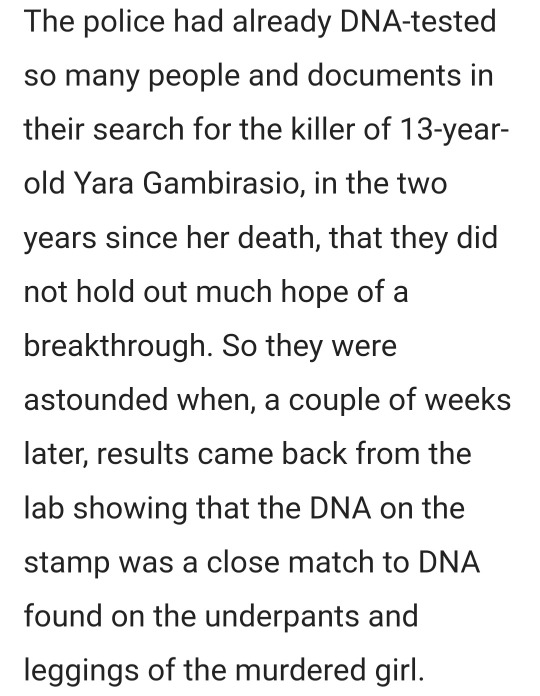




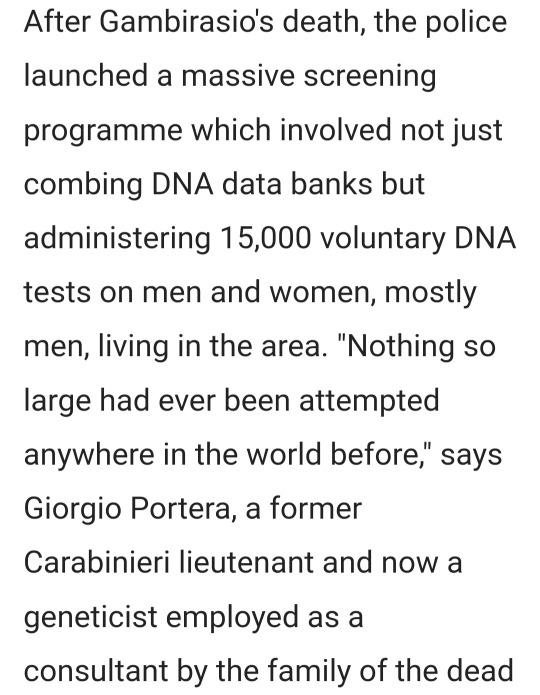

Among those asked to undergo the voluntary DNA tests were young men who frequented a disco called Le Sabbie Mobili (Quick Sand) near the field where the dead girl's body was found. These included Damiano Guerinoni whose DNA was very similar to that of the killer, who was by now nicknamed by police "Ignoto Uno" (Unknown One). This young man was unquestionably a close relative of the killer. Ironically, his mother, Aurora Zanni, had even worked for several years as a daily help for the dead girl's family. So police began to investigate his family. His father is one of 11 brothers and sisters. It was via this route that they arrived at the dead bus driver - one of his uncles - Giuseppe Guerinoni.
In September 2012 they went to the house of his widow, Laura Poli, in another small town near Bergamo called Clusone - 30 km northeast of Brembate di Sopra, in the foothills of the Alps. Clusone boasts one of the most impressive surviving external medieval murals: "The Triumph of Death" executed in 1485 by Giacomo Borlone de Buschis. Its inscription declares: Non e omo cosi forte, che da mi non po' schapare (No man exists strong enough to be able to escape from me.)
It was in Clusone - nearly two years after Yara's disappearance - that they made their first breakthrough. "Finding the marca da bollo on the driving license in the house of the bus driver's widow was a significant step forward," says Lieutenant Colonel La Russo. "It connected the killer with a real person at last - even if he was dead."
Giuseppe Guerinoni, who had died in 1999 aged 61 had three children with his wife who were quickly excluded as suspects. He was "a strong man able to live each day in symphony with his vital spirit," an old friend Antonio Negroni would later tell the press. It was clear, then, that he must also have had a child - a male child - out of wedlock and that this child was the killer.
Guerinoni's widow was no help. She was in the dark about her dead husband's extra-marital activities and, like all the major protagonists in this saga, she has declined to talk to the media. There was a total absence of old-fashioned clues as to the identity of the murderer; the only way to catch him was via modern science. The police reconstructed a biography of Guerinoni's private life and of every single woman he had ever known.
The magistrate on duty was Letizia Ruggeri, 45, a tough former policewoman, now Chief Investigator, who had earned her stripes fighting the Cosa Nostra in Sicily. Ruggeri's team searched orphanages and homes for "fallen women." They tested single mothers and women who had left the mountains for lower Bergamo. They came up empty-handed. The woman they were looking for, they realized, was probably neither single nor "fallen," but hidden behind the walls of a marriage. Divorce was only legalized in Italy in 1970 - until that time many couples had stayed together despite infidelities.
"We were met by a wall of silence, the kind of omerta that you associate not with the north of Italy but with Sicily and the mafia, but in the end we got there by means of patient, painstaking legwork," says La Russo.
It proved especially difficult for investigators to penetrate the mountain villages - Ponte Selva, Parre, Clusone and Rovetta - where they were looking for clues and leads. Some Italian journalists spoke of the "cocciutaggine," or pig-headedness, of the Bergamo Alps - a caricature which only served to antagonize the already defensive locals. "The people here," says Piero Bonicelli, the editor of Araberara, "were irritated by the stereotype of highlanders closed in on themselves. The word 'omerta' was even used, which implies [the silence of] Sicily and the mafia. It was deeply offensive."
This wariness towards outsiders owes much to the region's history. The city has always been a strategically important citadel, one of the last redoubts before the flat, fertile basin of the river Po. The Bergamaschi are used to seeing off invasions. Just a few miles west of Brembate di Sopra is a small town called Pontida, where in 1167 the Lombard League - the alliance of northern Italian cities which joined together to resist the German Holy Roman emperor, Frederick I - was formed. The Oath of Pontida still exerts a symbolic power today. It's frequently evoked by the separatists of the Northern League to rally sentiment against outsiders: against the perceived indolence and corruption of southern Italy or, more commonly now, against immigrants from developing nations.
Bergamo is also much closer to Switzerland than Naples, so the Bergamaschi are more generally reserved. "It's in the spirit of mountain people to disdain gossip and not to repeat nonsense," says Bonicelli. Bonicelli, a fan of the fictional detectives Maigret and Montalbano, also says, though, that the investigation was "lacking the traditional, human element: the sort of person who goes into a bar in the village...and puts someone at ease so that something slips out." Locals felt there was something cold about this investigation, with its invasive demands for DNA samples. And it was changing the atmosphere in these small communities. People thought, says Bonicelli, "that the murderer was here, amongst us. So there was a sort of - not panic, but fear."
The setting was part of what had fascinated the Italian public about Yara's disappearance. The province of Bergamo seemed to represent two different sides of the country. Where Lower Bergamo, towards the plains, is fashionable, well-connected and industrialized, Alpine Bergamo is agricultural, remote and deeply traditional, a close-knit place which nurtures suspicion, even superstition. Some locals talk, without irony, of this being a land of streghe, of witches, who steal or poison young children.
They located a former colleague of the bus driver, Vincenzo Bigoni, who told them: "Yes, he was a ladies' man and lots of young women traveled on his bus to and from work. One, at least, he got into trouble." But he was either unable or unwilling to reveal to police the name of that woman. He now risks prosecution for 'false testimony,' which is a crime in Italy as there is no right to silence there.
The police tracked down the woman from her DNA. Police identified 532 who the dead bus driver had known in his life with whom he could have had sexual relations and who were still alive. They DNA tested them all.
These women included Ester Arzuffi, now 67. Like all the other women identified by the police as women that knew Guerinoni, she consented to a DNA test without protest. Her DNA was a perfect match for that found on the dead girl - perfect in the sense that she is the mother of the killer, or so the investigators believed. "She has the female part of the DNA of Ignoto Uno," explains Portera.
Arzuffi had been a neighbor of Guerinoni's in Ponte Selva in the late 1960's. In 1966, aged 19, she had married Giovanni Bossetti, from Parre, a nearby village. Bossetti was a man whose tough life had turned him inwards: he had been orphaned young and suffered from psoriasis, arthrosis and depression. Arzuffi seemed very different: an outgoing, good-looking woman, she wore short skirts and dyed her hair. She got a job at the textile factory a few miles away in Villa d'Ogna, and took the bus every day. Arzuffi had left Ponte Selva in 1970, but continued the affair with Guerinoni, giving birth to twins.
Arzuffi has been married to the same man - Giovanni Bossetti - since 1967 when she was 19 years old. These days she and her husband also live in Brembate di Sopre. The couple have three children: two twins (a boy and a girl) born in 1970 - Massimo Giuseppe and Laura Laetizia - and a younger son - Fabio. The father of all three, everyone assumed, was her husband.
But the DNA tests revealed that the father of her twins is not her husband, but the dead bus driver Guerinoni. In other words, her eldest son - Massimo Giuseppe Bossetti - stood accused of being the killer. (Through leaks in the investigation, it was also discovered that Fabio had a different father too).
The police soon arrived at Bossetti, an apparently happily married 43-year-old carpenter who has three children aged 13, 10 and 7, and whose only quirk seemed to be a passion for sun lamp massage parlours.
One Sunday evening in June 2014, the police set up a roadblock near Bossetti's home in Mapello, a village a few kilometers from Brembate di Sopra, and flagged down his car. He was with his wife and three children. They breathalysed him, and he passed, so they let him proceed. But they now had his DNA on the breathalyser tube which they swiftly sent off to the lab for analysis.
There was a match between the DNA on the breathalyser and the DNA found on the girl's clothing. To be precise it showed 21 compatible markers (16 to 17 are normally considered enough). This means that the police, and their forensic experts are almost completely sure that he is the killer. He also has blue eyes, which the DNA found on the dead girl reveals her killer has. Bossetti had also passed through Brembate di Sopra the night of the murder on his way home from work.
A white Iveco truck, similar to his, was filmed by security cameras at the Shell petrol station opposite the gym in Brembate di Sopra at around 6pm and 10 minutes later by the video cameras of the Banca Credito Cooperativo near the girl's home. Bossetti went to the town frequently though to see his brother and his accountant, and had passed through it that night, he says, to avoid heavy traffic on the more direct route.
A few days later, the police arrested Bossetti at the building site where he worked. Bossetti's mother, Arzuffi, has spoken only once to the media - to the Corriere della Sera - when she denied having an affair with the bus driver but admitted that she had known him as a young woman.
Investigators discovered plenty of circumstantial evidence. Bossetti had frequently hung around Yara's house; he parked his car in Via Don Sala, behind the gym, and ate at the Toscanaccia pizzeria at the end of her road. He had gone for regular UV showers at a tanning shop nearby. His internet searches were troubling, using search words which implied a compulsion for pubescent young girls.
Meanwhile, three families dealt with devastation from the case. Guerinoni's widow has been forced, in the autumn of her life, to come to terms with her husband's infidelity and the existence of his other children. Meanwhile, just as he was diagnosed with terminal cancer, Giovanni Bossetti became the nation's most famous cuckold, learning at the same time as the rest of the country that none of his three children are his.
The marriage of the accused, Massimo Bossetti, had also come under strain: since his defense sought to portray him as a family man, two people came forward to claim that they had affairs with his wife. Bossetti's twin sister also had to come to terms with both her brother's fate and the fact that the man she thought was her father is not biologically related to her. Her mother, Ester Arzuffi, still denies she's ever been unfaithful to her husband.
#yara gambirasio#article#bergamo#italy#brembate di sopra#letizia ruggeri#ester arzuffi#giovanni bossetti#giuseppe guerinoni#piero bonicelli#massimo bossetti#true crime#solved#homicide#dna testing#chignolo d'isola#2010
3 notes
·
View notes
Text
Swab a cat and send it in to a DNA testing company under your name.
3 notes
·
View notes
Text
New from MyHeritage DNA: cM Explainer

MyHeritage DNA has unveiled cM Explainer™.“ This latest new feature “estimates familial relationships between DNA Matches,” calculates the probabilities associated with each potential relationship, and “determines the most recent common ancestor.” MyHeritage relies on the amount of shared DNA and the ages of one’s matches to refine predictions, just as 23andMe has done for years. Users can view an illustration of the relationship path for each of their genetic relatives. cM Explainer™ is now a free feature available to anyone with MyHeritage DNA results. Non-MyHeritage customers have the option to use cM Explainer™ as a free standalone tool at myheritage.com/cm.
Expect more product announcements this week as RootsTech 2023 continues.
#myheritage dna#MyHeritage#cM Explainer#product updates#RootsTech2023#genealogy#genetic genealogy#DNA#DNA testing#rootstech 2023#family history#autosomaldna
7 notes
·
View notes
Text
Jose Mier, Sun Valley, CA and DNA
Unraveling Ancestral Mysteries: DNA Testing for Genealogy
Jose Mier, amateur genealogist in Sun Valley, CA searches for others with the same name. As an aside, some of this research is actual genealogy. Today he delves into powerful tools that can aid that research. One is direct-to-consumer DNA testing, one of the tools listed in an article on the Family Tree Magazine website.
DNA test site…

View On WordPress
2 notes
·
View notes
Text

#african#afrakan#kemetic dreams#brownskin#afrakans#africans#brown skin#african culture#quest love#the roots#hip hop culture#african ancestry#dna testing
23 notes
·
View notes
Text
Can a 6 cM connection be meaningful?
When it comes to small DNA segments, we’ve heard the “glass half empty” version of the story many times. Here’s the other side of that story.
Submitted for your consideration: A pair of third cousins twice removed and their 6 cM connection…
According to AncestryDNA, Bryan Smith and his cousin, K, share 6 cM of DNA across 1 segment. And according to Ancestry’s ThruLines, Bryan and Cousin K share a pair of third great grandparents, Reuben Willis Smith and his wife Mary Connell.

The cM value is certainly consistent with the identified relationship but did Bryan and Cousin K inherit their shared DNA from the Smith ancestry as shown? Is the 6 cM segment even valid or could it be an artifact of an imperfect DNA matching algorithm?
Let’s start with an easy evaluation: the shared match list.
Among Bryan and K’s list of shared matches at AncestryDNA:
HG, a descendant of Reuben and Mary’s son, Charles Thomas Smith (HG shares 57 cM with Bryan)
RR, a descendant of Reuben and Mary’s daughter, Fannie Janes Smith (RR shares 47 cM with Bryan and 38 cM with K)
IG, another descendant of Reuben and Mary’s son, Charles Thomas Smith (IG shares 47 cM with Bryan and 71 cM with K)
And at least three other descendants of Reuben and Mary are on the shared match list.
So we’re off to a promising start. In addition to the fact that Bryan and K share DNA and a paper trail leading to Ruben and Mary, this group of matches gives us more evidence suggesting that Bryan and K might be related as suspected.
But what about that 6 cM segment shared by Bryan and K? Is it valid? Did it come from the shared Smith ancestors or did it originate elsewhere?
To get the most comprehensive help in answering these questions, we turn to GEDmatch. As indicated in the ThruLine image above, both Bryan and his father are related to DNA Cousin K through their Smith line. And because K is on GEDmatch, we can see that Bryan and his father both share DNA with K on a specific portion of Chromosome 12:

Further investigation reveals that two other descendants of Reuben and Mary, Cousins I and G, share DNA with Bryan and his father on Chromosome 12 in roughly the same location. In fact, all of the matches in question match each other on Chromosome 12:
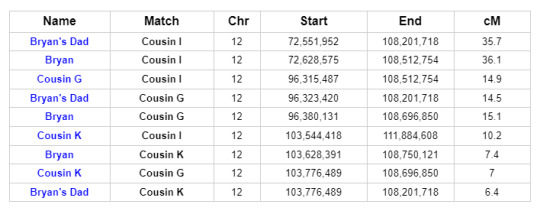
This is what we call a Triangulation Group. It brings the possible genetic connections into sharper focus.
The common segment shared by all of the members of this Triangulation Group indicates that they all share a common ancestor. And we’ve already identified shared ancestry through the Smith line. Cousins I and G are first cousins once removed and they are descendants of Reuben and Mary’s son Charles Thomas Smith...
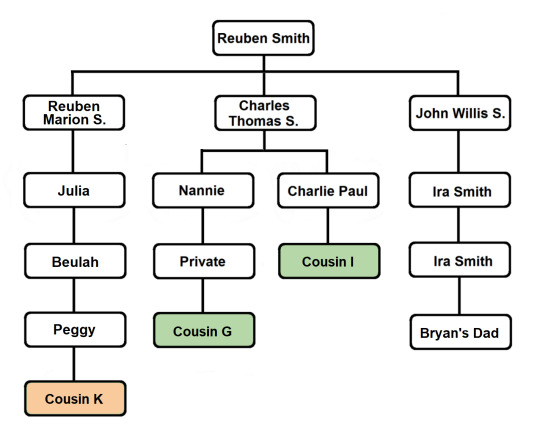
A review of the pedigrees of the matches in question reveals no lines of shared ancestry other than the known shared Smith line. This investigation is summarized briefly in the table below, listing 2nd great grandparent surnames and shared ancestors (blue for paternal names and surnames, light red for maternal names and surnames):
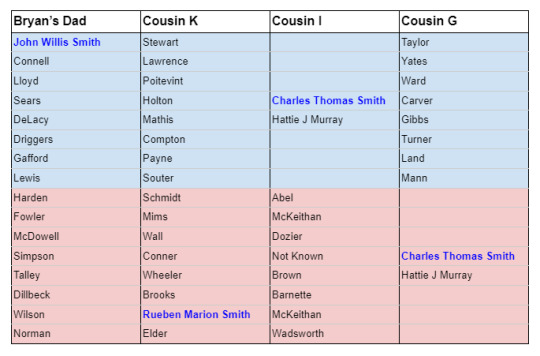
Although we cannot say with perfect certainty that there is no additional common ancestry that conceivably could account for the shared segment of DNA on Chromosome 12, the known evidence doesn’t leave room for much doubt.
For completeness, here’s a chart summarizing the amount of DNA shared by the relatives in question:

And cluster analysis for Cousin G yields a cluster with eight descendants of Reuben Willis Smith, including Bryan Smith and Cousin K:

Not everyone will feel the need to go this far to investigate a 6 cM connection. But this post provides examples of ways to investigate the validity of an ordinary small segment and to determine whether the shared DNA legitimately belongs with the presumed paper trail source of the DNA.
Discussion
Skepticism regarding small segments of shared DNA is appropriate. In comparison to larger shared segments, such segments are more likely to be IBS (false). Additionally, even when small segments can be shown to be reliable, we have to grapple with the fact that small segments can be too old to fall within the reach of reliable historical documentation.
With the exponential growth of the DNA matching databases, the impetus to explore distant matches waned. Reluctance to do the strenuous work involved in using small segments grew. With access to strong genetic connections leading back to target ancestors, why bother with low cM connections?
The sentiment is understandable!
On the other hand, I believe that excessive skepticism has impeded progress in genetic genealogy. As databases have grown, our opportunities for research have multiplied and our research techniques have improved. But at the same time, goalposts for small segment success have been moved to poorly-defined and very unreasonable points.
[From the skeptics: Your success with a small segment doesn’t count if you find a larger segment in a relative! I don’t want to hear about triangulation! Visual phasing is not allowed!]
If we applied such arbitrary restrictions to all areas of genealogy, we’d struggle to get our work done!
Even with our luxuriously large DNA databases, distant genetic connections are the only connections available in some areas of investigation (or to people who hail from less heavily-tested populations). Defeatist refusal to accept low cM matches as evidence in genetic genealogy needlessly limits our potential.
Don’t get me wrong, I’m fully in favor of scholarly rigor. But let’s not allow skepticism to pave the way for denialism!
When distant genetic connections are found to be of dubious quality, they should be set aside. But shared segments should not be judged on the basis of size alone. Even the most fervent opponents of small-segment research will admit that small segments are often valid (IBD). And while these opponents frequently cite IBD/IBS percentages, they ironically fail to see that our ability to find these percentages points directly to a practical method for sorting distant matches on an individual basis.
We are privileged to have access to enormous databases of incredibly valuable genetic information. More than a statistical hiccup that can lead us serendipitously to more reliable information, small DNA segments are messages we carry with us every day, testifying to our connections with our ancestors. Genetic information, even in small amounts, can be just as valuable as any other form of information. We should be good stewards of that information and we should invest good faith effort in understanding how our distant matches can inform us about our rich ancestral history.
I’ll close with this analogy for small segments:
You want some refreshing water but the glass is only half-full. Drink it or toss it out?

Posted with Bryan Smith’s permission. 17 May 2023
#genetic genealogy#DNA testing#DNA#small segments#visual phasing#Triangulation#dna segment#DNA segment triangulation#DNA clustering#clustering#pedigree#family tree#ThruLines
3 notes
·
View notes
Text
It makes me so mad that Jace and Clary just believed Valentine when he told them they were siblings like a) why would you believe a literal cult leader and b) a simple dna test would’ve solved that within a day 🤷♀️
#its the 21st century#cmon guys#let’s use that little thing in our skull#TMI#tmi#the mortal instruments#the mortal cup#jace wayland#jace herondale#jace morgenstern#clary fray#clary fairchild#clary x jace#jace x clary#dna#dna testing
34 notes
·
View notes
Text
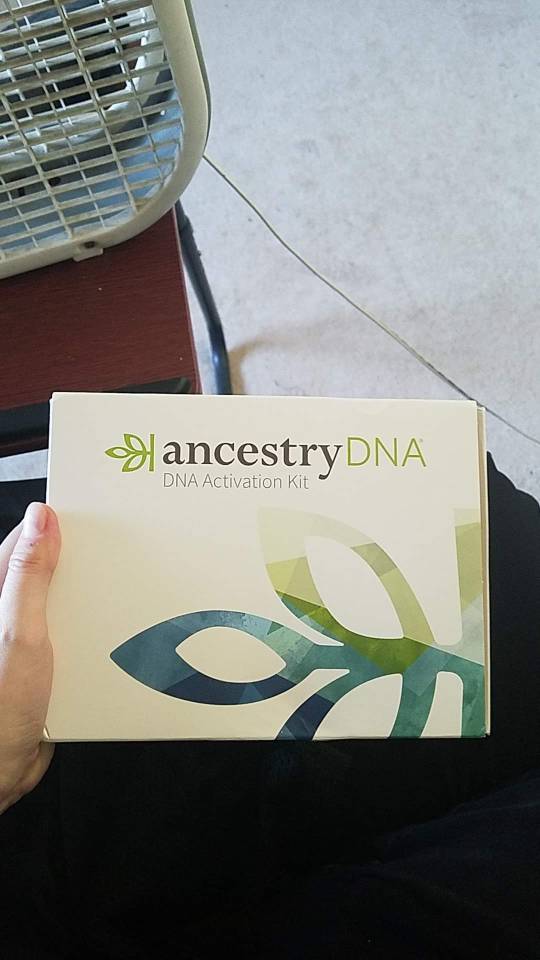
I've never been so nervous to spit into a tube.😅
#dna testing#ancestry#ancestry dna#ancestry dna test#dna test#nervous#I've never been so nervous to spit into a tube
3 notes
·
View notes
Text
Want to know what is frustrating about genealogy, well at least the DNA part?
Not knowing the connection. Can not figure out the connection for a variety of reasons.
Adoption. Finding out the person you call Grandpa isn't your Grandpa. People just not knowing their own family history. None of this is their faults of course.
But when I, who lives in Canada has a DNA connection to 62 people who live in New Zealand and Australia, and none of us can figure out how we are related.
Until just the other day. One beautiful woman sent in her DNA and guess what? She has done her family tree. Her and the other 61 people all connect through my 4x great grandfather.
Almost all of his descendants went to Australia and New Zealand, while one line came to Canada.
6 years. 6 years of trying to figure it out. Then one person sends in the DNA and BAM...all the pieces fall into place.
41 notes
·
View notes